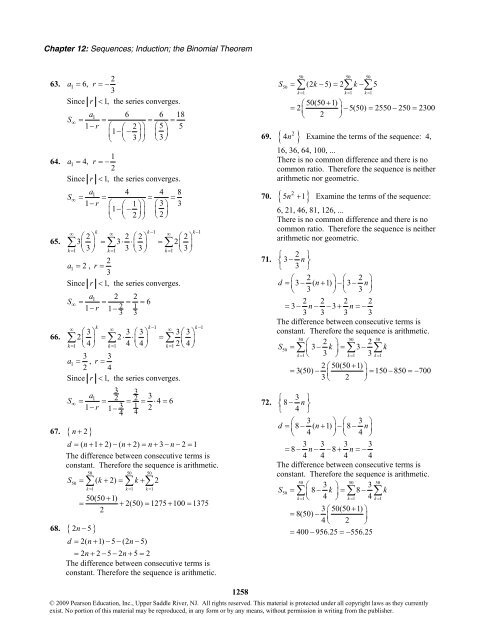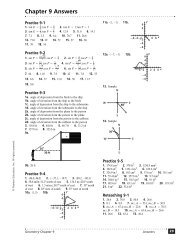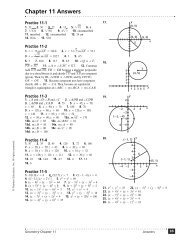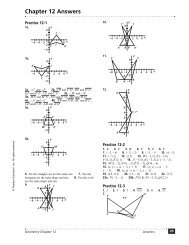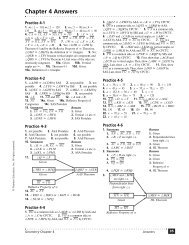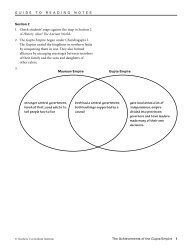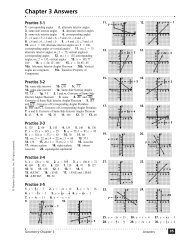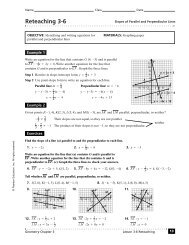Chapter 12 Sequences; Induction; the Binomial Theorem
Chapter 12 Sequences; Induction; the Binomial Theorem
Chapter 12 Sequences; Induction; the Binomial Theorem
You also want an ePaper? Increase the reach of your titles
YUMPU automatically turns print PDFs into web optimized ePapers that Google loves.
<strong>Chapter</strong> <strong>12</strong>: <strong>Sequences</strong>; <strong>Induction</strong>; <strong>the</strong> <strong>Binomial</strong> <strong>Theorem</strong><br />
2<br />
63. a1<br />
= 6, r = −<br />
3<br />
Since r < 1, <strong>the</strong> series converges.<br />
a1<br />
6 6 18<br />
S∞<br />
= = = =<br />
1− r ⎛ ⎛ 2 ⎞⎞ ⎛5<br />
⎞ 5<br />
⎜1−⎜− ⎟ ⎜ ⎟<br />
3<br />
⎟<br />
⎝ ⎝ ⎠⎠<br />
⎝3<br />
⎠<br />
1<br />
64. a1<br />
= 4, r =−<br />
2<br />
Since r < 1, <strong>the</strong> series converges.<br />
a1<br />
4 4 8<br />
S∞<br />
= = = =<br />
1− r ⎛ ⎛ 1 ⎞⎞ ⎛3<br />
⎞ 3<br />
⎜1−⎜− ⎟ ⎜ ⎟<br />
2<br />
⎟<br />
⎝ ⎝ ⎠⎠<br />
⎝2<br />
⎠<br />
65.<br />
66.<br />
∞ k ∞ k−1 ∞ k−1<br />
⎛2⎞ 2 ⎛2⎞ ⎛2⎞<br />
∑3⎜ ⎟ = ∑3⋅ ⋅ ⎜ ⎟ = ∑ 2⎜ ⎟<br />
k= 1 ⎝3⎠ k= 1 3 ⎝3⎠ k=<br />
1 ⎝3⎠<br />
2<br />
a 1 = 2 , r =<br />
3<br />
Since r < 1, <strong>the</strong> series converges.<br />
a1<br />
2 2<br />
S∞<br />
= = = = 6<br />
1−<br />
r 1−<br />
2 1<br />
3 3<br />
∞ k ∞ k−1 ∞ k−1<br />
⎛3⎞ 3 ⎛3⎞ 3⎛3⎞<br />
∑2⎜ ⎟ = ∑2⋅ ⋅ ⎜ ⎟ = ∑ ⎜ ⎟<br />
k= 1 ⎝4⎠ k= 1 4 ⎝4⎠ k=<br />
<strong>12</strong>⎝4⎠<br />
3 3<br />
a<br />
1<br />
= , r =<br />
2 4<br />
Since r < 1, <strong>the</strong> series converges.<br />
3 3<br />
a1<br />
2 2 3<br />
S∞<br />
= = = = ⋅ 4=<br />
6<br />
1−<br />
r 1−<br />
3 1 2 4 4<br />
67. { n + 2 }<br />
d = ( n+ 1+ 2) − ( n+ 2) = n+ 3−n− 2=<br />
1<br />
The difference between consecutive terms is<br />
constant. Therefore <strong>the</strong> sequence is arithmetic.<br />
50 50 50<br />
S = ( k + 2) = k+<br />
2<br />
50<br />
68. { 2n − 5}<br />
∑ ∑ ∑<br />
k= 1 k= 1 k=<br />
1<br />
50(50 + 1)<br />
= + 2(50) = <strong>12</strong>75 + 100 = 1375<br />
2<br />
d = 2( n+ 1) −5 −(2n−5)<br />
= 2n+ 2−5− 2n+ 5=<br />
2<br />
The difference between consecutive terms is<br />
constant. Therefore <strong>the</strong> sequence is arithmetic.<br />
50<br />
50 50 50<br />
∑ ∑ ∑<br />
S = (2k − 5) = 2 k−<br />
5<br />
k= 1 k= 1 k=<br />
1<br />
⎛50(50 + 1) ⎞<br />
= 2⎜<br />
⎟− 5(50) = 2550 − 250 = 2300<br />
⎝ 2 ⎠<br />
2<br />
69. { 4n } Examine <strong>the</strong> terms of <strong>the</strong> sequence: 4,<br />
16, 36, 64, 100, ...<br />
There is no common difference and <strong>the</strong>re is no<br />
common ratio. Therefore <strong>the</strong> sequence is nei<strong>the</strong>r<br />
arithmetic nor geometric.<br />
2<br />
70. { 5 1}<br />
71.<br />
72.<br />
n + Examine <strong>the</strong> terms of <strong>the</strong> sequence:<br />
6, 21, 46, 81, <strong>12</strong>6, ...<br />
There is no common difference and <strong>the</strong>re is no<br />
common ratio. Therefore <strong>the</strong> sequence is nei<strong>the</strong>r<br />
arithmetic nor geometric.<br />
⎧ 2 ⎫<br />
⎨ 3 − n ⎬<br />
⎩ 3 ⎭<br />
⎛ 2 ⎞ ⎛ 2 ⎞<br />
d = ⎜3 − ( n+ 1) ⎟−⎜3−<br />
n⎟<br />
⎝ 3 ⎠ ⎝ 3 ⎠<br />
2 2 2 2<br />
= 3− n− − 3+ n =−<br />
3 3 3 3<br />
The difference between consecutive terms is<br />
constant. Therefore <strong>the</strong> sequence is arithmetic.<br />
50 50 50<br />
⎛ 2 ⎞ 2<br />
S50<br />
= ∑⎜<br />
3− k ⎟= ∑3−<br />
∑k<br />
k= 1⎝<br />
3 ⎠ k= 1 3 k=<br />
1<br />
2 ⎛50(50 + 1) ⎞<br />
= 3(50) − ⎜ ⎟= 150 − 850 =−700<br />
3⎝<br />
2 ⎠<br />
⎧ 3 ⎫<br />
⎨ 8 − n ⎬<br />
⎩ 4 ⎭<br />
⎛ 3 ⎞ ⎛ 3 ⎞<br />
d = ⎜8 − ( n+ 1) ⎟−⎜8−<br />
n⎟<br />
⎝ 4 ⎠ ⎝ 4 ⎠<br />
3 3 3 3<br />
= 8− n− − 8+ n =−<br />
4 4 4 4<br />
The difference between consecutive terms is<br />
constant. Therefore <strong>the</strong> sequence is arithmetic.<br />
50 50 50<br />
S ⎛ 3 3<br />
50<br />
8 8<br />
1 4 k ⎞<br />
= ∑⎜<br />
− ⎟= ∑ − ∑<br />
k k 1 4<br />
k<br />
= ⎝ ⎠ = k=<br />
1<br />
3 ⎛50(50 + 1) ⎞<br />
= 8(50) − ⎜ ⎟<br />
4⎝<br />
2 ⎠<br />
= 400 − 956.25 =−556.25<br />
<strong>12</strong>58<br />
© 2009 Pearson Education, Inc., Upper Saddle River, NJ. All rights reserved. This material is protected under all copyright laws as <strong>the</strong>y currently<br />
exist. No portion of this material may be reproduced, in any form or by any means, without permission in writing from <strong>the</strong> publisher.


